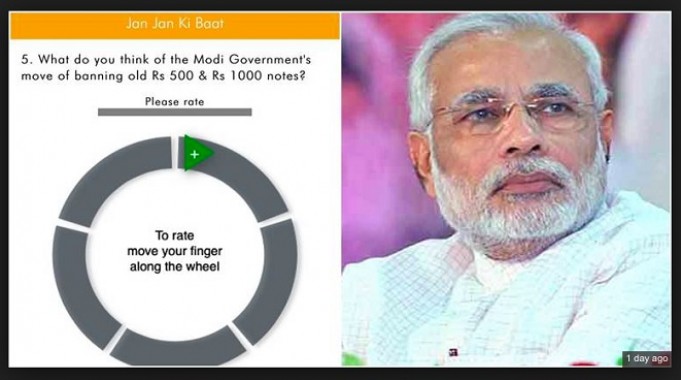The NM App: A story for some, a non-story for others
A survey on the Narendra Modi App measuring people’s responses to demonetisation has drawn attention not only because of the incredible looking data (the very high number of people supporting demonetization) generated by it but also because of the glaring mismatch between the official media in the form of All India Radio (AIR) and DD News and the bulk of the print media.
The results of the survey were released on November 23 and these dominated the AIR bulletins on that night, as well as the next morning. It was also the leading news on Thursday morning for DD News, but a look at 19 leading English and Hindi newspapers on this morning revealed that this top AIR-DD news was simply ignored by the print media, or else given a very brief and cursory mention.
Seldom has there been such a mismatch between the top story of AIR-DD news bulletins and its near total absence in the leading newspapers.
To get the basic facts first, on Tuesday November 22, Narendra Modi announced an online survey to gauge people’s response to demonetization. The results of this survey were announced the next day and were considered important enough to be presented at a Cabinet meeting.
The results revealed that 90 per cent of the respondents support the policy, 92 per cent think that demonetization will curb the three evils of black money, terrorism and corruption, and 90 per cent think that the government’s efforts to tackle black money have been brilliant or nice. According to the papers, these results were based on the responses of 500,000 people.
Along with the results of the survey, Mr Modi tweeted: “I thank people for the historic participation in the survey. It is satisfying to read the insightful views and comments.”
However, opposition leaders were quick to dismiss the survey as a gimmick. Congress spokespersons found fault with the way the questions were framed, the lack of a disagreement option, and the urban-centric nature of the survey. For a change, the AIR news bulletins in the morning gave adequate space to the Congress viewpoint.
CPI leaders made a somewhat similar criticism of rural people being ignored but this left unanswered the question of whether such high support for demonetization exists even in urban areas.
A day before the survey results came in, the Rajasthan Patrika made the survey the lead news in its Delhi edition. While listing all the 10 questions asked in the survey, the newspaper reported, on the basis of its sources, that they elicited many interesting responses. Among the responses quoted by the newspaper there are negative as well as positive responses towards demonetization.
One woman said she had no money for food. Another respondent said the survey reflects a dictator’s mindset and that he or she wanted to vote in the negative but this choice was not available. Yet another respondent said different survey methods should be found so that common people could participate. One respondent wondered pointedly how the 70 dead people could give their opinion. One said the entire country was with Modi and another second he followed Modi blindly.
In short, the responses as analysed by Rajasthan Patrika are much more diverse compared to the 90 per cent figure.
This skepticism about the survey results appears to be the reason for the muted responses of print journalists to the survey findings in the newspapers of November 24. Had the 90 per cent figure been credible, it would have been a big story. Instead, several newspapers ignored it while others underplayed it.
The Times of India reported it on page 15 in a very small two column news item. Although the Indian Express, Hindustan and Navbharat Times mentioned the survey on the front page, there was very little by way of endorsement. Amar Ujala published just one sentence on page one drawing attention to a small news item on the survey on page 13 while the rest of the newspaper carried several more detailed reports about the sufferings caused to farmers and other ordinary people.
In fact, anyone who has followed this issue since demonetization was announced on November 8, will find it very hard to believe that over around 90 per cent of people support this move without any ifs and buts. Therefore the larger question remains about how such data was generated and how attempts are made to create public opinion on this basis. It is disturbing to think that even ‘facts’ can be manufactured in highly dubious ways. Then again, in these ‘post-truth’ days, maybe not.
Bharat Dogra is a freelance journalist who has been involved with several social movements and campaigns.







